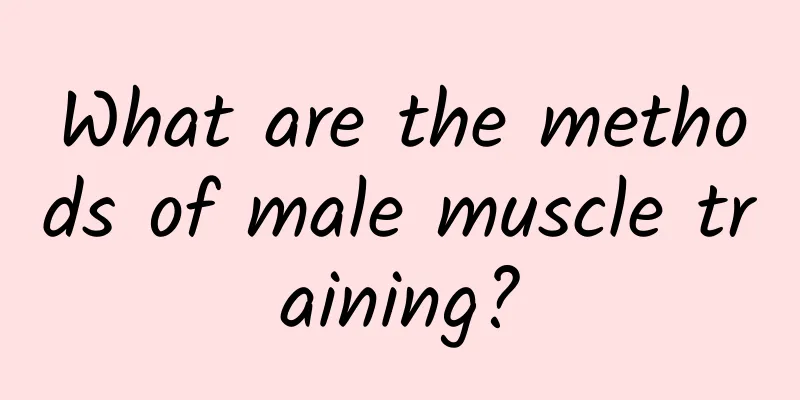What is the function of the chest muscles? How to train the chest muscles

|
Many men pursue a body with perfect lines and curves, such as developed pectoralis major and abdominal muscles. So how to train the pectoralis major and abdominal muscles? What is the function of pectoralis major? The role of chest muscles First, it protects the heart and buffers external pressure. Secondly, you can do pull-ups with your chest muscles to exercise the arm muscles and back joint muscles, making your body stronger, increasing your strength, and making your physique more perfect. It can adduct and internally rotate the humerus. When the upper limbs are fixed, you can lift the trunk and ribs to help inhale. The fullness of the chest muscles mainly affects whether you push outward or hold inward with too little force. In addition, if the chest muscles are full, they have a protective effect on the bones and organs covered by them that cannot be ignored. How to train your chest muscles Barbell Overhead Press A. Key areas to be trained: pectoralis major, deltoids and triceps. Most champion bodybuilders consider the supine press as the best exercise for the upper body. B. Starting position: Lie on your back on a flat bench with your feet flat on the ground. Hold the horizontal bar with your palms facing up, slightly wider than your shoulders, and stretch your arms to support the barbell on the upper part of your chest. C. Movement process: Stretch your arms straight to the sides, slowly bend your arms, and let the barbell drop vertically until the horizontal bar touches your chest (approximately above the nipple line). Then push up to the open position and repeat. D. Training points: Do not arch your back and buttocks or hold your breath, as this will cause your muscles to lose control and is dangerous. Dumb Bell Lying Push A. Key exercise areas: pectoralis major, deltoids and triceps. B. Starting position: Lie on your back on a flat bench with your feet flat on the ground. Hold the dumbbells with your palms facing upward. C. Movement process: Open your arms straight to the sides, slowly bend your arms, and let the dumbbells fall vertically. When they reach the lowest point, push up and exhale. Then push up to the open position and repeat. D. Training points: Do not arch your back and buttocks or hold your breath, as this will cause your muscles to lose control and is dangerous. Double Bar Dips A. Key exercise areas: mainly the lower part of the pectoralis major, followed by the triceps and deltoids. B. Starting position: The distance between the two bars should be wider than the shoulders. Hold the bar with both hands to support it with straight arms, straighten the chest, and tighten the abdomen. Straighten the legs and relax them to droop. C. Movement process: Exhale, bend the elbows and bend the arms, and lower the body until the arms are bent and lowered to the lowest position. The head should be led forward and the elbows should be abducted to fully stretch the pectoralis major. Immediately inhale, and support the arms with the sudden contraction of the pectoralis major to raise the body until the arms are fully straightened; when the upper arms exceed the horizontal position of the bar, the hips are slightly retracted, and the trunk is in a "head down and chest tucked" posture. When the arms are straight, the pectoralis major is in a completely tightened state. Repeat the exercise. D. Training points: The movements should be performed slowly, and do not rely on the swing of the body to complete the movements; when pushing up, the speed should be fast, chest and head should be raised, abdomen should be contracted, and shoulders should not be shrugged; to increase the intensity of the training, weights can be placed around the waist for training. Incline Bell Press A. Key training areas: upper pectoralis major, followed by anterior deltoid and triceps. B. Starting position: lying on a bench with an incline angle of 35-45 degrees. C. Movement process: the distance between the two hands is slightly wider than the shoulders, and the arms are straight to support the barbell above the shoulders. Inhale when lowering it to the top of the chest (close to the clavicle). As soon as the horizontal bar touches the chest, push up and exhale when pushing up. D. Training points: Generally, a wider grip is used, and the horizontal bar is lowered to the clavicle. This method allows the chest muscles to be used more force. Incline dumbbell press A. Key training areas: upper pectoralis major, followed by anterior deltoid and triceps. B. Starting position: lying on a bench with an incline angle of 35-45 degrees. C. Movement process: hold dumbbells above the shoulders with both arms straight. Inhale when lowering to the top of the chest (close to the clavicle). When you reach the lowest point, do the push-up movement and exhale when pushing up. D. Training points: During the training process, the main force will be concentrated on the pectoralis major, so that the chest muscles are always in a tense state. The triceps are used as a secondary supplementary force. |
<<: Key steps of prostatectomy and postoperative care
>>: Why is hair oily? Four common reasons
Recommend
What causes left scrotum pain?
The health of male genitals has a great impact on...
I've learned a lot! It's actually the cause of my inability to urinate and my inability to urinate completely.
Do you feel like you can't urinate with force...
Which should I apply first, sunscreen or foundation?
Many girls are confused about which one to apply ...
What is the cause of the sediment in the urine?
Men sometimes find their urine cloudy when they u...
Male urethral pain
Under normal circumstances, people's urethra ...
What are the symptoms of epididymitis?
Testicular health is very important for men, but ...
Redness and swelling around the glans coronal groove
A circle of redness and swelling at the glans cor...
What should men with high blood pressure eat?
We all know that hypertension is a very troubleso...
What can men eat to nourish their kidneys?
If a man has kidney deficiency, it will have a gr...
What foods can men eat to replenish their bodies?
Men who are often busy with work and family will ...
What to do if you have erection pain all the time
Erection is closely related to male sexual functi...
Why do men become sexually apathetic despite being full of vigor?
In the sexual life of both sexes, men usually dom...
Male urine red
Male friends must pay attention if they find that...
What causes testicle and lower abdomen pain?
Male diseases are similar to female gynecological...
What are the methods to prevent prostate leukocytes?
The increase of prostate white blood cells is a p...









